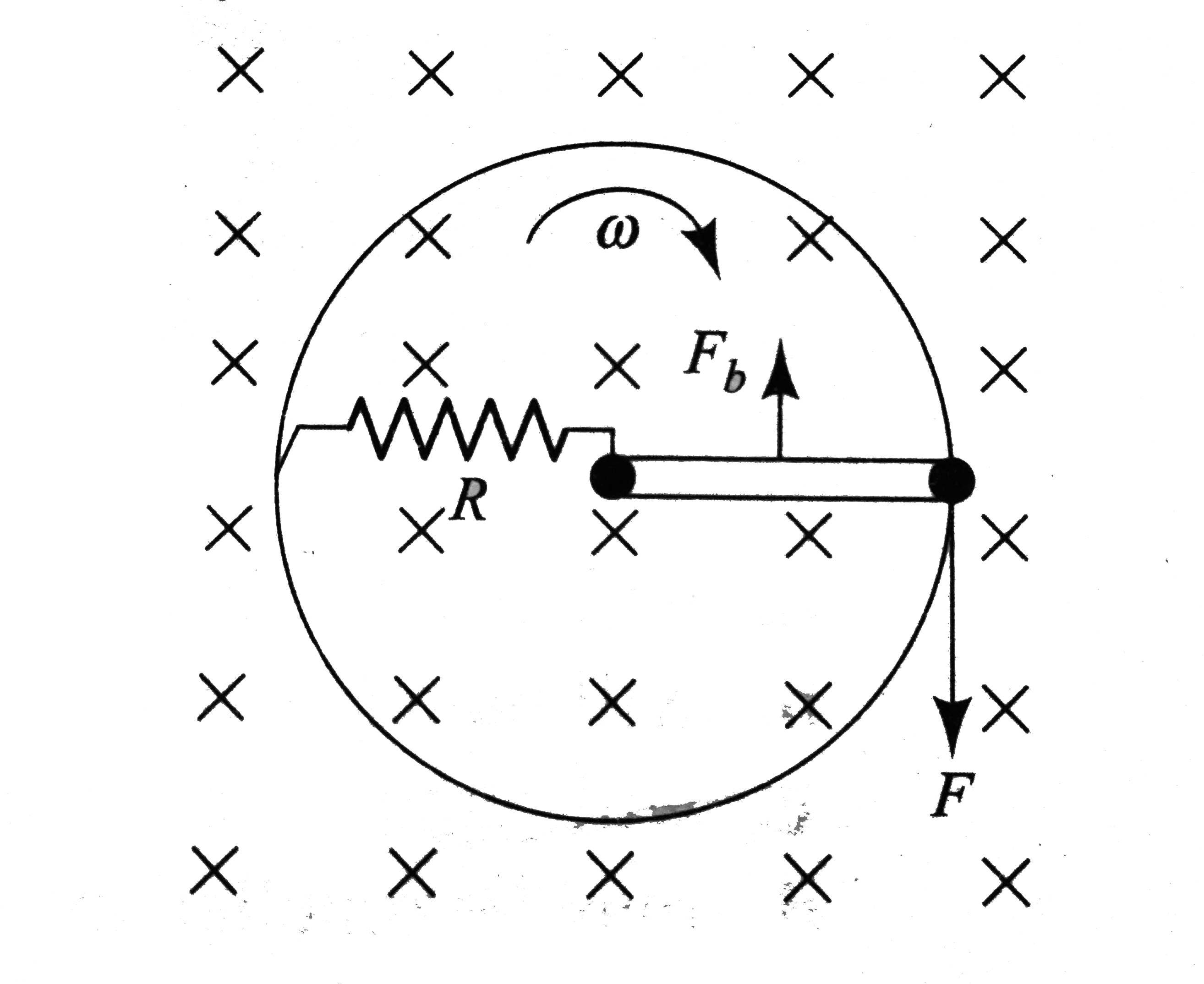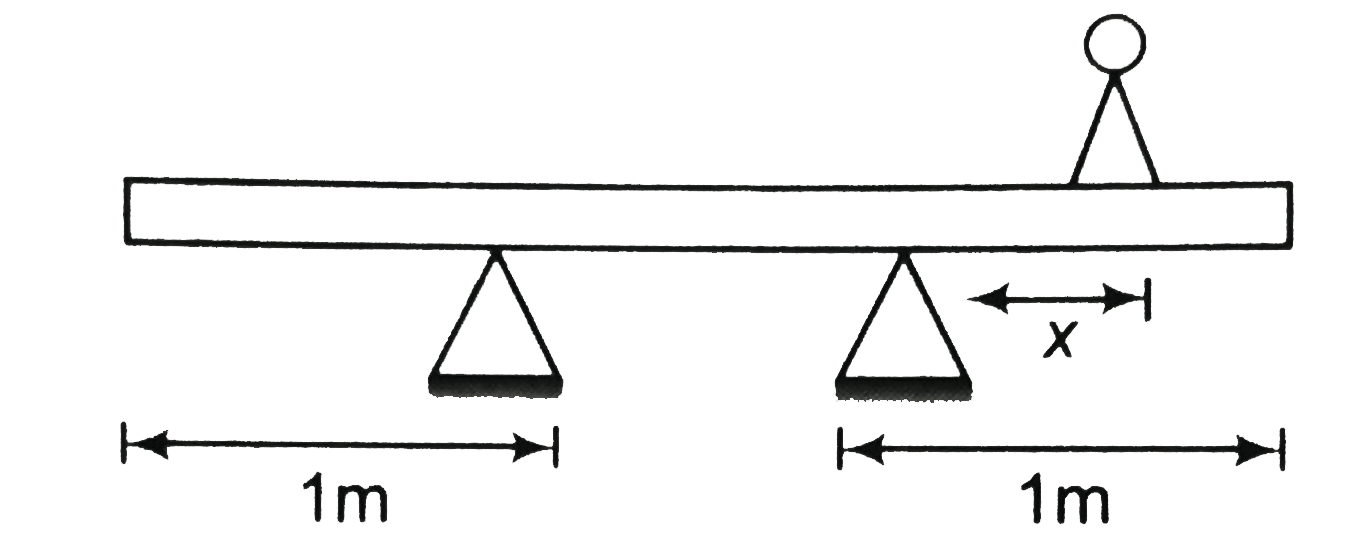A thin, 50 cm long metal bar with mass 750 g rests on, but is not attrached to, two metallic supports in a uniform 0.450T magnetic field, as shown in fig. A battery and a 25Ω resistor in series are connected to the supports.

What is the largest voltage the battery can have without breaking the circuit at the supports?
817
718
827
837
The correct Answer is:1
As F−mg when the bar is just ready to levitate,
IIB=mgorI=mglB=0.750×9.80.5×0.45A=32.67A
ε=IR=(32.67)(25)V=817V
Topper's Solved these Questions
- MOVING CHARGES AND MAGNETISMBOOK - NARAYNACHAPTER - MOVING CHARGES AND MAGNETISMEXERCISE - Level-II(C.W)
63 Videos
- MOVING CHARGES AND MAGNETISMBOOK - NARAYNACHAPTER - MOVING CHARGES AND MAGNETISMEXERCISE - LEVEL-III
45 Videos
- MOVING CHARGES AND MAGNETISMBOOK - NARAYNACHAPTER - MOVING CHARGES AND MAGNETISMEXERCISE - C.U.Q-KEY
121 Videos
- MAGNETISM AND MATTERBOOK - NARAYNACHAPTER - MAGNETISM AND MATTEREXERCISE - EXERCISE - 4 (SINGLE ANSWER TYPE QUESTION)
17 Videos
- NUCLEAR PHYSICSBOOK - NARAYNACHAPTER - NUCLEAR PHYSICSEXERCISE - LEVEL-II-(H.W)
9 Videos
Similar Questions
A thin, 50.0cm long metal bar with mass 750g rests on, but is not attached to, two metal supports in a 0.950T magnetic field as shown in figure. A battery and a resistance R=25.0Ω in series are connected to the supports.

(a) What is the largest voltage the battery can have without breaking the circuit at the supper
(b) The battery voltage has this maximum value calculated. Decreasing the resistance to 2.0Ω the initial acceleration of the bar.
View SolutionIn the circuit shown in fig. 7.24 , all the resistors are rated at a maximum power of 1.00W. What is the maximum emfε that the battery can have without burning up any of the resistors?

View Solution
Knowledge Check
A thin, 50 cm long metal bar with mass 750 g rests on, but is not attrached to, two metallic supports in a uniform 0.450T magnetic field, as shown in fig. A battery and a 25Ω resistor in series are connected to the supports.

The battery voltage has the maximum value calculated in above question. If the resistor suddenly gets partially short-circuited, decreasing its resistance to 2Ω, find the initial accleration of the bat.A113ms−2B55ms−2C180ms−2D12.4ms−2A pair of parallel conducting rails lie at right angle to a uniform magnetic field of 2.0T as shown in the fig. two resistor 10Ω and 5Ω are to slide without friction along the rail. The distance between the conducting rails is 0.1m. Then
 AInduced current =1150A directed clockwise if 10Ω
AInduced current =1150A directed clockwise if 10Ω
resistor is pulled to the right with speed 0.5ms−1 and resistor is held fixedBInduced current =1300A directed anti-clockwise if
10Ω resistor is pulled to the right with speed 0.5ms−1 and 10Ω resistor is held fixedCInduced current =1300A directed clockwise if 5Ω
resistor is pulled to the left at 0.5ms−1 and 10Ω resistor is held at resDInduced current =1150A directed anti-clockwise if5Ω
resistor is pulled to the left at 0.5ms−1 and 10Ω resistor is held at restA metallic ring of radius r with a uniform metallic spoke of negligible mass and length r is rotated about its axis with angular velocity ω in a perpendicular uniform magnetic field B as shown in Fig. 3.163. The central end of the spoke is connected to the rim of the wheel through a resistor R as shown. The resistor does not rotate, its one end is always at the center of the ring and the other end is always in as shown is needed to maintain constant angular velocity of the wheel. F is equal to (the ring and the spoke has zero resistance)
 A(a) B2ωr28RB(b) B2ωr22RC( c) B2ωr32RD(d) B2ωr34R
A(a) B2ωr28RB(b) B2ωr22RC( c) B2ωr32RD(d) B2ωr34R
A straight wire of length 50 cm carrying a current of 2.5 A is suspended in mid-air by a uniform magnetic field of 0.5 T (as shown in figure). The mass of the wire is (g = 10 ms−2)

View SolutionA wire of 62.0cm length and 13.0g mass is suspended by a pair of flexible leads in a uniform magnetic field of magnitude 0.440T in figure. What are the magnitude and direction of the current required to remove the tension in the supporting leads? Take g=10ms2

View SolutionA horizontal plank is 10.0m long with uniform density and mass 10kg .It rests on two supports which are placed 1.0m from each end as shown in the figure. A man of mass 80 kg can stand upto distance x on the plank without causing it to tip .The value of x is

View SolutionA brilliant student of physics developed a magnetic balance to weight objects. The mass m to be measured is hung from the center the bar. Bar is kept in a uniform magnetic field of 1.5T directed into the plane of the figure. Battery voltage can be adjusted to vary the current in the circuit. The horizontal bar shown is 60cm long and is made of extremly light weight material. It is connected to the battery via a resistance. There is no tension in the supporting wired. The magnetic force only supports the hanging weight.

Which point of battery is positive?
View SolutionA brilliant student of physics developed a magnetic balance to weight objects. The mass m to be measured is hung from the center the bar. Bar is kept in a uniform magnetic field of 1.5T directed into the plane of the figure. Battery voltage can be adjusted to vary the current in the circuit. The horizontal bar shown is 60cm long and is made of extremly light weight material. It is connected to the battery via a resistance. There is no tension in the supporting wired. The magnetic force only supports the hanging weight.

If V=150V, what is the maximum mass m ?
View Solution
